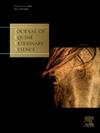Hormonal changes and sperm quality of stallions after testicular thermal insult
IF 1.3
3区 农林科学
Q2 VETERINARY SCIENCES
引用次数: 0
Abstract
Testicular thermal insult negatively affects spermatogenesis and it's a common cause of testicular degeneration. Changes in semen quality after heat stress are well understood but its effects in hormone synthesis still not well characterized. Recently, hormones produced by Sertoli cells as antimulleriano hormone (AMH) and Inhibin-B have been suggested as potential fertility biomarkers. Thus, the aim of this study was to verify the changes in hormone profile, especially serum inhibin-B and AMH after scrotal insulation. Stallions (n=6) were submitted to scrotal insulation for 1 hour in the morning and 1 hour in the afternoon, for two consecutive days, using a thermal blanket surrounding the scrotum. The intratesticular temperature was measured immediately after the blanket was removed and increased ∼10oC during the insulation time. The stallions were weekly evaluated for 98 days after the procedure. Testicular response was assessed by measuring testosterone and estrone sulphate (interstitial compartment) and AMH and inhibin-B (tubular compartment). Sperm kinetics were evaluated by CASA (IVOS Version 12 Hamilton Thorne Research, MA, USA), sperm concentration by Neubauer hemocytometer (Optik LaborⓇ, Lancing, England), serum concentrations of AMH, inhibin- B and estrone sulfate were determined by ELISA and testosterone by RIA. Lipid peroxidation, plasma membrane stability (MPAI) and superoxide anion generation were assessed by flow cytometry (BD LSR II, Becton Dickinson, Mountain View, CA, USA) and sperm morphology by differential phase interference contrast microscope. The correlations between semen parameters and hormones were analyzed by Pearson correlation analysis. Testosterone correlated with MT (r=0,39), RAP (r=0.34), sperm concentration (r=0.29), MPAI (r=0.26), head defects (r= - 0.49) and total sperm defects (r= - 0.37). Estrone sulfate correlated with MT (r=0.3908), RAP (r=0.3401), sperm concentration (r=0.37), head defects (r=-0.42) and total sperm defects (r=-0.41). Inhibin-B positively correlated with sperm concentration (r=0.41) and negatively with total sperm defects (r=-0.39), whereas AMH did not correlate with the other sperm parameters evaluated. In conclusion, the correlation between hormones and sperm output indicates these hormones, besides AMH, are good markers for testicular harm and recovery when damages are caused by thermal insults.
求助全文
约1分钟内获得全文
求助全文
来源期刊

Journal of Equine Veterinary Science
农林科学-兽医学
CiteScore
2.70
自引率
7.70%
发文量
249
审稿时长
77 days
期刊介绍:
Journal of Equine Veterinary Science (JEVS) is an international publication designed for the practicing equine veterinarian, equine researcher, and other equine health care specialist. Published monthly, each issue of JEVS includes original research, reviews, case reports, short communications, and clinical techniques from leaders in the equine veterinary field, covering such topics as laminitis, reproduction, infectious disease, parasitology, behavior, podology, internal medicine, surgery and nutrition.
 求助内容:
求助内容: 应助结果提醒方式:
应助结果提醒方式:


